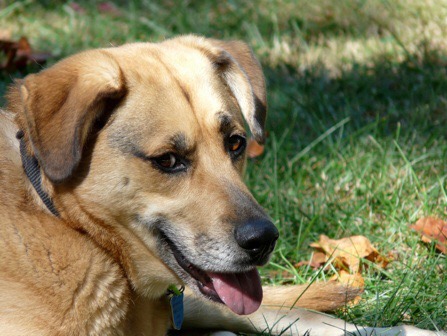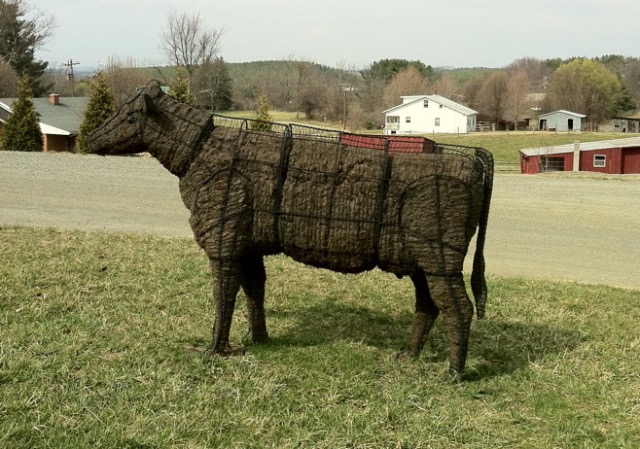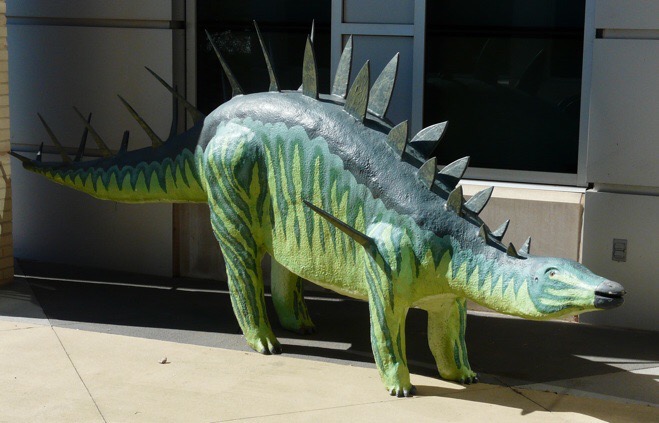 Inspired by Roy Mason's lecture at WSC last Thursday I decided to republish this post from my old blog. This was originally published at my old blog, "Updates from the Paleontology Lab" on April 6, 2011 under the title "And now for something a little different...". It seems that one of my dogs, Molly, doesn’t like large animals. I’m not sure why this should be the case, since she’s pretty much never been around any large animals except the deer that occasionally wander into our backyard. But if she spots a deer, horse, or some other large animal in the distance it generally results in a fit of barking and growling that is completely different from her normal demeanor.This behavior might seem a little out of character for Molly, but it’s not really surprising as it seems to be pretty commonplace in domestic dogs. But what I did find surprising was that Molly went into her aggressive, anti-large animal mode when she saw this:
Inspired by Roy Mason's lecture at WSC last Thursday I decided to republish this post from my old blog. This was originally published at my old blog, "Updates from the Paleontology Lab" on April 6, 2011 under the title "And now for something a little different...". It seems that one of my dogs, Molly, doesn’t like large animals. I’m not sure why this should be the case, since she’s pretty much never been around any large animals except the deer that occasionally wander into our backyard. But if she spots a deer, horse, or some other large animal in the distance it generally results in a fit of barking and growling that is completely different from her normal demeanor.This behavior might seem a little out of character for Molly, but it’s not really surprising as it seems to be pretty commonplace in domestic dogs. But what I did find surprising was that Molly went into her aggressive, anti-large animal mode when she saw this:
 Now, when we look at this we immediately think “cow”, and apparently so does Molly (or at least whatever the dog word is for “cow”). But if you really look at this, it's pretty stylized for a cow. While we think “cow” we know it’s not a real cow. But how do we know? What features are we looking at that tell us “fake cow” instead of “real cow”? Maybe it’s the wire frame, or the incorrect texture, or these and other things besides. So maybe our subconscious thought process goes something like this (and I’m just generalizing here, so don’t nitpick too much):head + ears + long body + four legs + tufted tail + cow size = cow(cow) + wire frame + non-furry texture = fake cowWhy is this interesting? Because Molly clearly wasn’t getting the “fake cow” message. She sees some feature or combination of features and thinks “cow” and ignores the features we see that tell us “fake cow”. Dogs have good eyesight, so Molly should be able to see things like the wire frame; she just doesn’t recognize the significance of those things. So her brain is taking in a subset of the data available to it, and using that subset to identify “cow”.When Molly initially saw the cow, she was in the car with the windows up. As we pulled up next to the cow, we rolled down the window, and she sniffed. Then she stopped barking and pretty much ignored the cow. So Molly’s identification process may go like this:head + ears + long body + four legs + tufted tail + cow size = cow(cow) + non-cow smell = fake cowBut she didn’t rely on the smell to make her initial identification, so presumably either of these pathways work for her:head + ears + long body + four legs + tufted tail + cow size = cowhead + ears + long body + four legs + tufted tail + cow size + cow smell = cowIt’s also interesting that the absence of a cow smell (and presence of whatever she did smell) was enough to override all her prior interpretations based on what she could see. She seems to be weighting some observations more heavily than others.In fact, her whole process seems to have a familiar pattern:Hypothesis: Based on visual observations, I think that’s a cow. If it is a cow, it should smell like a cow. (Null hypothesis: It’s not a cow.)Procedure: Sniff to see if it smells like a cow.Result: It doesn’t smell like a cow.Conclusion: It’s not a cow (the null hypothesis is not rejected).My dog is a scientist!There is one more interesting observation concerning Molly; the cow is not the first time she’s had this kind of reaction to a life-size animal model. A few years ago, she showed the same reaction to this:
Now, when we look at this we immediately think “cow”, and apparently so does Molly (or at least whatever the dog word is for “cow”). But if you really look at this, it's pretty stylized for a cow. While we think “cow” we know it’s not a real cow. But how do we know? What features are we looking at that tell us “fake cow” instead of “real cow”? Maybe it’s the wire frame, or the incorrect texture, or these and other things besides. So maybe our subconscious thought process goes something like this (and I’m just generalizing here, so don’t nitpick too much):head + ears + long body + four legs + tufted tail + cow size = cow(cow) + wire frame + non-furry texture = fake cowWhy is this interesting? Because Molly clearly wasn’t getting the “fake cow” message. She sees some feature or combination of features and thinks “cow” and ignores the features we see that tell us “fake cow”. Dogs have good eyesight, so Molly should be able to see things like the wire frame; she just doesn’t recognize the significance of those things. So her brain is taking in a subset of the data available to it, and using that subset to identify “cow”.When Molly initially saw the cow, she was in the car with the windows up. As we pulled up next to the cow, we rolled down the window, and she sniffed. Then she stopped barking and pretty much ignored the cow. So Molly’s identification process may go like this:head + ears + long body + four legs + tufted tail + cow size = cow(cow) + non-cow smell = fake cowBut she didn’t rely on the smell to make her initial identification, so presumably either of these pathways work for her:head + ears + long body + four legs + tufted tail + cow size = cowhead + ears + long body + four legs + tufted tail + cow size + cow smell = cowIt’s also interesting that the absence of a cow smell (and presence of whatever she did smell) was enough to override all her prior interpretations based on what she could see. She seems to be weighting some observations more heavily than others.In fact, her whole process seems to have a familiar pattern:Hypothesis: Based on visual observations, I think that’s a cow. If it is a cow, it should smell like a cow. (Null hypothesis: It’s not a cow.)Procedure: Sniff to see if it smells like a cow.Result: It doesn’t smell like a cow.Conclusion: It’s not a cow (the null hypothesis is not rejected).My dog is a scientist!There is one more interesting observation concerning Molly; the cow is not the first time she’s had this kind of reaction to a life-size animal model. A few years ago, she showed the same reaction to this:
 I very seriously doubt that there’s a dog word for Kentrosaurus. And yet something that Molly sees here triggers at least a “big animal” reaction, and it overrides all the (to her) unfamiliar features of a dinosaur. So what are the critical features that tell Molly that this is an animal? I have no idea, but it would be interesting to find out.OK, I admit this really doesn’t have much to do with paleontology or geology. But it’s still intriguing to think about the implications of observations like this for cognition and sensory perception.
I very seriously doubt that there’s a dog word for Kentrosaurus. And yet something that Molly sees here triggers at least a “big animal” reaction, and it overrides all the (to her) unfamiliar features of a dinosaur. So what are the critical features that tell Molly that this is an animal? I have no idea, but it would be interesting to find out.OK, I admit this really doesn’t have much to do with paleontology or geology. But it’s still intriguing to think about the implications of observations like this for cognition and sensory perception.
